 |
| Lisandro Alonso: “The Searchers is the main example of what a Western was by John Ford, films which I really admire.” (Chiara Mastroianni and Robert Alan Packard in Eureka) |
Lisandro Alonso’s Delphic Eureka, co-written with Martín Caamaño and Fabian Casas (which had its world premiere at the Cannes Film Festival in 2023 and was a Main Slate selection of the New York Film Festival), begins with Murphy (Viggo Mortensen) approaching a town in the old Wild West on a buckboard, driven by a nun. She cannot be trusted, so much is clear, and as though she were the coachman transporting Dr. Van Helsing to his destination in Transylvania, she tells her passenger that this is as far as she can go. In the saloon he will encounter El Coronel (Chiara Mastroianni channeling Joan Crawford in Nicholas Ray’s Johnny Guitar), and a messy, loud and altogether corrupt atmosphere that doesn’t bode well for his mission, namely the search for his missing daughter.
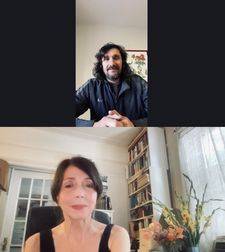 |
| Lisandro Alonso with Anne-Katrin Titze on Alice Rohrwacher and Apichatpong Weerasethakul: “You mentioned two filmmakers that I really like a lot!” |
Following a surprising and elegant transition, the second part of Alonso’s tryptic drops us off in present day Pine Ridge Reservation in South Dakota, where the weather report threatens with temperatures of 25 below zero and heavy snow storms (announced by a reporter in a sleeveless dress). We join real-life policewoman Alaina Clifford on her shift, as she responds to calls that lead her to a remote house where drug addicts live in squalor, stranded people on the icy roads, a domestic dispute, and a casino shooting. Alaina is on her own, despite repeated calls for backup to the dispatcher. Her niece Sadie (Sadie Lapointe) coaches basketball, her responses are like poetry, and her Nike T-shirt symbolically foreshadows a transformative decision.
Sadie’s grandfather (Stanley Good Voice Elk) proclaims that “time is a fiction invented by men,” and off we soar with a big white bird into the Brazilian rain forest of 1974 where a group of indigenous people tell each other dreams. Part three shows a life seemingly in tune with nature, until we see a Pepsi can float by the waterfall (reminiscent of the Coke can anachronistically bobbing in the waves in Frauke Finsterwalder’s Sisi & I). We are always at all times. Progress is hard to come by, and there’s always the question for whom.
From La Pampa Province, Argentina, Lisandro Alonso joined me on Zoom for an in-depth conversation on Eureka.
Anne-Katrin Titze: Hi!
Lisandro Alonso: Hello! Nice to meet you.
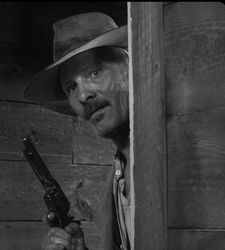 |
| Lisandro Alonso on Viggo Mortensen as Murphy: “There's still no civilization where he's trying to see what is happening with his daughter.” |
AKT: Nice to meet you, too. Where are you?
LA: I'm in the province of La Pampa, in Argentina. It is in the South, the farm.
AKT: I'm in a very hot New York.
LA: Okay, yeah, I can see. Well, enjoy it.
AKT: I will! One more day, and then it's going to feel like autumn in New York. Let's talk about Eureka. You begin with the nun as a coach woman, which already, I think, sets the tone perfectly for what we're about to see. It is clearly not Stagecoach. We're in for something else. She says to her passenger: "This is as far as I go,” which is a warning for us. It is Van Helsing going to see Dracula.
LA: Ha, yes, well, I thought it was a complex structure film, and at the moment when I was writing the script, I thought I should start just putting the audience in the place of a Western frontier back in time. Western films, I thought that was a good starting point for me to put the character who is played by Viggo Mortensen in a desert place where there's no rules, and there's still no civilisation where he's trying to see what is happening with his daughter.
And actually, it's kind of a continuation on what I did before in my previous film called Jauja. There’s a father, played by Viggo Mortensen, also looking for his daughter. But I thought it was a good starting point for me, because I don't know why. Since I'm from South America, you always dream in some way to make a Western, a black and white Western. I organise the film in some way that you can make connections between the three parts of the film, or it can be useful for you to create ideas on what the film is about.
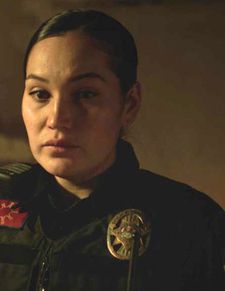 |
| Lisandro Alonso on police officer Alaina Clifford: “I'm really used to working with non-professional actors …” |
AKT: I noticed that in the three parts there are many scenes that have a double in another. In the second part there is also a search for a girl, the policewoman is searching for Mackenzie. You mentioned your other film with Viggo Mortensen, where there was also the search for a daughter. Of course, John Ford's The Searchers is the first Western that comes to mind that has this theme. And Slavoj Žižek, I don't know if you're familiar with the Slovenian philosopher? Do you know Žižek?
LA: By the name. I don't follow him that much. But yeah, by the name.
AKT: He called Taxi Driver a remake of The Searchers [in Sophie Fiennes’s The Pervert’s Guide To Ideology].
LA: Yeah, absolutely. Yes!
AKT: Because she doesn't want to be found. She doesn't want to be rescued. And you're doing a similar thing.
LA: Yeah. Well, actually, that's a good point. I didn't notice it. But yes, The Searchers is the main example of what a Western was by John Ford, films which I really admire. But at some point, I guess, there were a lot of Western films made by John Ford and many other filmmakers that at this point of society, probably wouldn't be possible to exist for the way that they show minorities. In that precise Western, The Searchers, there's a couple of scenes that probably would and should, bring a lot of trouble to the studio nowadays to be made.
With the idea to shoot this kind of an intro in the Western in my film, I was trying to put the audience into what a Western was back in time. Those films, especially the Westerns, the bad ones, a lot of them were not too useful for the people who really were involved in the history, in the histories of what the Western was showing, especially the natives.
 |
| Lisandro Alonso on Hiroshige’s 100 Famous Views Of Edo featuring Takashi Murakami with Anne-Katrin Titze at the Brooklyn Museum: “Amazing! I love that.” Photo: Ed Bahlman |
AKT: You show this town, which looks dangerous, and even "the room with a view" is shabby. And then in the second part we see the present time, a very real present that is in relation to times past. We are dealing with this in the now, a kind of suffering and mess on the reservations that is connected to a history that is undealt with.
LA: Yeah, that's another possible very good connection. I don't think that the main issues changed a lot for the people who were involved in those films, and there is the result of what those films present. They are still alive, especially for the communities now, especially for those minorities who live in the Pine Ridge Reservation, which you can see. They have a lot of troubles there that they cannot handle on their own. They still need some help.
AKT: And am I correct that the policewoman is an actual policewoman?
LA: Yes, I'm used to it from all the films I made. I made like four or five films and I'm really used to working with non-professional actors, with people that I just found on the town, in the towns. Or just walking on the farms or in the street, people that probably never went to a cinema to see a movie. They don't know how to read, or they don't really understand what the film is made for. So I try to really connect part of my work as a filmmaker.
 |
| Sadie LaPointe as the basketball coach |
I really want to use cinema in order for me to approach those places and people, and try to share some kind of project together. I'm from Argentina. I'm not used to be in the United States, but back in time I received a couple of invitations to do a fellowship between New York and Boston, and I started thinking about what I would like to put my body and my camera in. And I went straight to Pine Ridge because I had a deep interest in showing this kind of area somehow.
AKT: The policewoman's life, the way she is so much on her own all the time with only the dispatcher's voice in this car is powerful. We ask: Why is there nobody else? Why is there nobody coming for her? Here is the opposite of what you showed before, the woman who doesn't want to be rescued. This has nothing to do with the fact that she's a woman, but just give her some backup! Give her some more police!
LA: When I did arrive for the first time in Pine Ridge - I have been traveling to Pine Ridge for four or five years in different seasons, and I just introduced myself to the police station, and I told them that I really was shocked by the way they are working in that community. They are only like 20 or 23 police officers in order to cover more than 50,000 people. They never stop. So there's a lot of opportunities that they open doors and the people inside the house are probably family. And they have to nevertheless keep going, trying to help and put some order in those places. And I think it's really deep, and very sad somehow.
AKT: Did you ever see a film by Alessandro Comodin, an Italian film called The Adventures of Gigi, the Law? Two years ago it was in the New York Film Festival. And it takes place mostly in a police car with the filmmaker's uncle driving through the Friuli region in Northern Italy. He's a policeman, and somehow I saw a parallel between his and your film. I'm sure you would enjoy it.
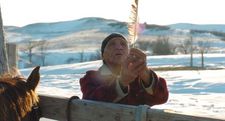 |
| Stanley Good Voice Elk, Sadie’s grandfather |
LA: I will pay attention to watch that one!
AKT: Let's talk about the transformation and the bird. All three parts of Eureka take place in the Americas. But I was reminded of something very different. Hiroshige's woodblock from 19th century Japan. [I hold up the image].
LA: Amazing! I love that. I think it's a kind of a mythical way of reincarnation that I used. I probably just took it from some other place unconsciously, you know? And actually, if I had to be honest, I needed to put those places in connection. So I thought it was a good idea to ask, what is going to happen with that girl, and try to fly her in order to see and show a place where I'm more nearby, you know, like South America, like in a jungle, and try to observe the differences between how natives live in the US and how natives live in South America.
AKT: It's funny how you put her in a Nike T-shirt!
LA: But no, yeah. But I didn't choose her costume.
AKT: You didn't?
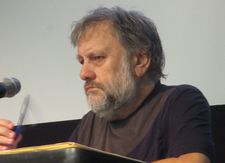 |
| Slavoj Žižek called Taxi Driver a remake of The Searchers in Sophie Fiennes’s The Pevert’s Guide to Ideology Photo: Anne Katrin Titze |
LA: No, no, she really wants to be an actress, but this one was her first character, so I just called her, because I thought she was really really pure. But yeah, I noticed that. But I thought it was like normal and nice.
AKT: It's lovely, the connection to Nike, the winged goddess. The use of myth subverts the brand and becomes something totally different.
LA: Yeah, wonderful.
AKT: This transformation and the way you use myth and transform the myth, and work with it in a different way, made me think of Alice Rohrwacher and how her films are always taking something traditional that is very local. Turning it into cinema, makes it different. Apichatpong Weerasethakul does this as well.
LA: You mentioned two filmmakers that I really like a lot! We are kind of friends. So I'm inspired by them. It's kind of a small club around these kind of filmmakers around the globe. But yes, you are totally right. Yes, she especially, well, both of them, I mean. Yeah. Both of them can create these kind of mythical and mystical travellings around places that you cannot imagine.
AKT: Your bird could travel into the films by either one of them!
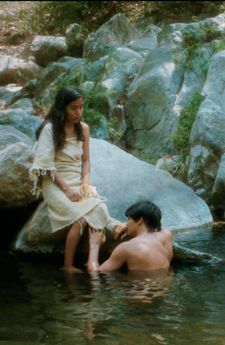 |
| Liliana Alvarez with Adanilo |
LA: I would love for that to happen!
AKT: Yes, just tell Alicia, I have a bird for you!
LA: I will write her about it! It can be a good starting point, you know?
AKT: Yeah. Say hi from me, I've had conversations with her and her sister. That'd be great. I was surprised by the gathering you chose in your third part. There wasn't anything mythological, but they were telling each other about their dreams. There were not any folktale traditions that I recognised. Is this ritual of telling dreams something that you stumbled upon or is it what you told them to do?
LA: I just write down some ideas with Fabian Casas’s support that I work with for the script, and I tell them. But then they have to translate it into their own languages and everything. I just try to be as literal as I can. Especially the language that they talk has only 3,000 people that can understand it. So I think I just manipulate a little bit the dreams or what they say, but not a lot. But I really want to make a contrast between those natives who live still in the green zone, in the nature they can survive from, and put it against the people who live in Pine Ridge, where they cannot even dream anymore.
So I thought it was a balance between how we can observe different ways of being, even if what is happening there at the Amazon is like, 30 years ago, 50 years ago, I think they still can live from nature, and they can just get together in one place and on a sunny day tell what they are dreaming. It didn't mean that the people from the United States, especially in Pine Ridge, don't have any more dreams to tell, but I thought it was a good way to show different attitudes to life.
AKT: The drug house, in a way, felt like the dark doubling of the dream scene.
 |
| Lisandro Alonso on Alice Rohrwacher using his bird in Eureka: “I will write her about it! It can be a good starting point” Photo: Anne Katrin Titze |
LA: Yeah, yeah. And even if I really didn't want to show every kind of political issue that happened, since I chose to observe from the police, I thought it was fair to show. How is that kind of reality?
AKT: Messiness dominates many of the places you show. And there are only two, where the mess is beautiful. There's a history in the mess, in the fabric and material. One of them is the woman near the end, the other is the grandfather before the transformation. These places stand in contrast to the drug house and the saloon in the first part. How much were your hands in staging the messes?
LA: Well, actually, not a lot. I mean, in the Western part, we were shooting in Spain, in Almeria, where they made these spaghetti Westerns before. And then when we moved to shoot in South Dakota. Actually, I rather prefer to use the natural places. Actually, we just touch it a little bit, some backgrounds, but not a lot. I thought those places really represent the essence of what I wrote in the script. I didn't have to look for a thousand houses. I mean, there's a lot of houses that represent that kind of messy state.
AKT: What about Chiara Mastroianni? She is very Johnny Guitar-like in the beginning and then she is stranded in the snow. And surprisingly she is not El Coronel in the third part.
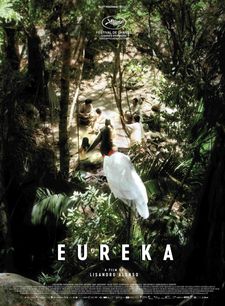 |
| Eureka poster |
LA: Actually she was. She was planned to play the Coronel in the third part. But since I had to put this shooting in context, we were stopped by the pandemic, you know Covid? We were stopped two or three times during the shooting, so at the moment that we shot the jungle in Mexico, the protocols of health were impossible for her, so she could not come there. She could not fly there because she had to do some quarantine for a month in order to shoot three or four days. So it was not possible and I had to replace her. But yes, she looks like Johnny. That was a great inspiration for us, and I love the way she took this risk about being the double character, especially in the Pine Ridge, where she has to ask a lot of questions that we all might have, wanting to know about what is happening there.
AKT: Apropos, Johnny, I have to tell you about something I witnessed recently. The song we hear at the beginning of your film is the classic Civil War song “When Johnny Comes Marching Home Again”. About two weeks ago, here in New York in the park, I saw a group of pre-schoolers, maybe four years old, walking in a line with their teacher who was singing this Civil War song with them, albeit with changed lyrics. It felt like a strange return of the repressed, very eerie.
LA: Yeah, something is returning somehow.
AKT: Space and time, the tropes in your film!
LA: Even if we don't want that. But it seems it's happening. You know, it's like, it might happen worldwide.
AKT: Thank you so much for this!
LA: I hope we can talk some more in the future. I will talk to Alicia, and I will mention your idea. Enjoy New York on the last summer day!
Eureka opens in the US on Friday, September 20.





















